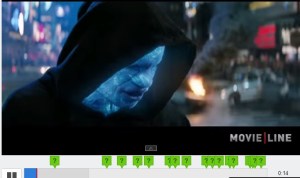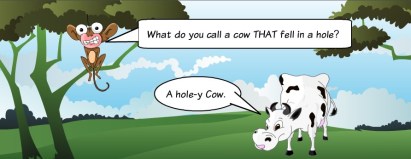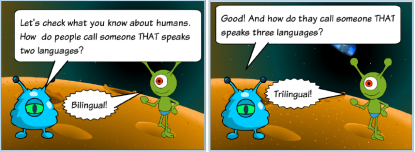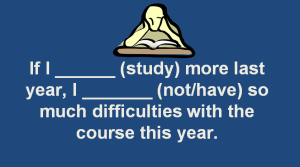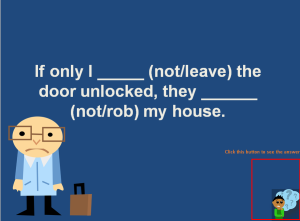Category Archives: esl
Body Image – Vocabulary Activities
| Aim: | To practice words related to body image and appearance |
| Interaction: | Individually or in groups |
| Exercise type: | Filling in the gaps, constructing sentences |
| Language: | B2 or C1 |
| Time: | 15-20 minutes |
| Materials: | Handouts, an electronic device to reproduce a youtube video |
Previously, I posted an activity based on the Illusionist trailer (Kick Me Vocabulary Game – Words to talk about body image and appearance). No need to mention that I like the trailer and the movie a lot, so much actually that I have developed two more activities based on it. One of them foocuses on collocations and another one on the sentence structure and word order.
1. Start by showing your student the first 90 seconds of the teaser of The Illusionists film and ask them to complete the collocations in their handout.
You may choose to do an introductory activity to encourage your students to brainstorm the topic and the related vocabulary. Some ideas for the introductory activities for this trailer can be found in the post Kick Me Vocabulary Game – Words to talk about body image and appearance (will open in a new tab/window).
The _____________________ of the body |
The ____________ of _______ beauty |
The_________ that corporations have on our ________ of ourselves |
To ____________ people’s insecurities about their bodies for profit |
The ________ with __________________ beauty is as old as time |
The ________ of the ________ body has _______ the central role |
75% of “normal” weight women think they are __________ |
The ________ of body dissatisfaction around the world |
90% of women ________ their body size |
Our culture’s ___________ ________ physical appearance |
The _________ impact our __________________ culture has on women |
An interactive online activity is available here Vocabulary – Body Image
Here are the answers:
- the commodification of the human body
- the marketing of unattainable beauty around the world
- the influence that corporations have on our perception of ourselves
- to manipulate people’s insecurities about their bodies for profit
- the pursuit of the perfect beauty has taken the central role
- 75% of “normal” weight women think they are overweight
- The epidemic of body dissatisfaction around the world
- 90% of women overestimate their body size
- Our culture’s obsession with physical appearance
- The alarming impact our celebrity-obsessed culture has on women.
Make sure that everybody understands all the vocabulary from the previous activity. Provide clarification if one or more of your students are not sure about the meaning of some words or phrases.
Distribute the handout with a chart below. The students can work individually or in groups.
Instruct the students that they need to arrange the words in each of the lines to make sentences. Remind your students about the word order in an English sentence [the subject always goes before the verb and adjectives go before the nouns that they describe (we say Happy Birthday not Birthday Happy J )]
Tell the students that there is a hint for them: a capitalized word in each line is the first word of a sentence.
The students need to write their sentences in the space provided in each line.
1. as property Commodification body human treating means of the a person |
2. models Runway set standards beauty unattainable |
3. beauty perceptions of our Magazines influence TV and |
4. about Many bodies teenagers insecurities have their |
5. new nothing is A preoccupation beauty physical with |
6. price The pursuit has of a high price the body perfect |
7. develop problems people Overweight can health various |
Both handouts with instructions for the students can be downloaded here: Body image and appearance vocabulary activities
Previously, I also shared several ideas for speaking activities on fashion and appearance which can be found here and two activities and a matching game on adjectives to describe personality and appearance which can be found here.
Have fun learning and leading in the classroom!
Kick Me Vocabulary Game – Words to talk about body image and appearance
| Aim: | To practice words related to body image and appearance |
| Interaction: | Whole class (any, preferably at least 3) |
| Exercise type: | Matching, filling in the gaps |
| Language: | B2 or C1 |
| Time: | 15-20 minutes |
| Materials: | Post-it notes or strips of paper with tape; a handout with a chart for each of the students |
Since the majority of the words that are used in the exercise can be found in the first 90 seconds of the Illusionists trailer, you may choose to do an introductory activity to familiarize your students with the vocabulary.
An Introductory Activity
Show your students the first 90 seconds of a very short teaser of the Illusionists film:
Ask the students the following questions before starting the activity:
- What do you think the film is about?
- Do you think the film approves of cosmetic surgery for vanity?
- What alarming statistics are mentioned in the teaser?

- What do these numbers refer to:
- Would you consider undergoing a plastic surgery just to change your appearance?
- Do you know someone who has undergone a cosmetic surgery?
- Could you name some arguments in favor and against plastic surgeries?
Preparing for the Activity
1. Take 12 post-it notes and write the following words on them. Write each word on a separate post-it note:
Celebrity-obsessed
Unattainable
Perception
Overweight
Overestimate
Commodification
Repugnant
Rebellious
Prejudice
Epidemic
Pursuit
To take the central role
You can also use strips of paper and tape instead of post-it notes.
2. Stick a post-it note to the back of each of the students without telling your students which word they have. If you have less than 12 students, some students may end up with two post-it notes on their backs.
Alternatively, if you have very few students (3 or 4), you can choose to hide words around the classroom (under the chairs, under the desks) or stick them on the walls around the classroom. If you choose this option, then in the third column of the handout the students will need to write down the name of the object on which they found the word and its location in the classroom.
If you have more than 12 students, then repeat some of the words, so that each of the students has a post-it note on their backs.
3. Give each student a handout with a chart.
If you have a very large classroom, you may choose to give one handout for two or three students and allow them to work in a group.
Activity
1. Each of the students needs to walk around the classroom, looking at the backs of other students and the words that they have.
Remind the students that they are allowed to communicate only in English.
2. Once a student finds on someone’s back a word that fits one of the gaps in the chart, the student writes down this word and the name of the student who is wearing this word.
3. The first student to complete the chart correctly wins and gets an extra point.
4. If you have several students filling in one handout, then the group that fills in their handout first wins.
The handout and the explanation can be downloaded here: Body image and appearance Kick Me Vocabulary Game
Previously, I also shared several ideas for speaking activities on fashion and appearance which can be found here and two activities and a matching game on adjectives to describe personality and appearance which can be found here.
Adjective to Describe Personality and Appearance – Two Activities and a Matching Game
Previously I shared several ideas for speaking activities on fashion and appearance which can be found here.
In this post I want to concetrate on the vocabulary to describe appearance and personality. All three activities have been desined for B2 students and have been successfully used in my classroom.
The first activity is picture based and is aimed at introducing or reviewing adjectives to describe clothes. Check it out in a slideshow below.
Students need to choose the correct adjectives to describe the clothes in each of the pictures. Sometimes more than one adjective can be used to describe a picture.
The next activity is aimed at reviewing the adjectives to describe appearance, the task of the students is to complete the sentences with the correct adjective from the box.
And finally a matching game with compound adjectives.
You can read the description below or download it here together with the cards: Compound Adjectives To Describe personality and Appearance – Matching Game
| Cmpound Adjectives To Describe personality and Appearance – Matching Game | |
| Aim: | To practice compound adjectives related to personality and appearance |
| Interaction: | Individually or in groups of up to 3 students |
| Exercise type: | Matching |
| Language: | B2 |
| Time: | 7-12 minutes |
| Materials: | A set of cut up cards for a person or for a group |
| Procedure: |
Have Fun! |
Have fun learning and leading in the classroom! 🙂
Film Reviews – Vocabulary Workshop and Lesson Plan.
Film reviews are one of the most popular topics in TEFL and this is exactly what we were dealing with over the last week. Coursebooks don’t always do a great job in engaging students especially when it comes to reading and vocabulary exercises, so to assist my students, struggling with vocabulay aquisition, I developed the following vocabulary workshop.
The activity is based on a film review by Movieline and presents new words in context and with other words that they go with (i.e. horizontally). The visuals in the clip add a powerful element and help students to memorize the vocabulary easier and faster.
The activity could also be used to introduse a possible rhetorical structure of an oral film review (possible because there are other ways to structure a review).
Level: B2
Target skill: vocabulary
Other skills involved: reading, listening, rhetorical structure of an oral film review.
1. As a lead-in activity quickly go through some vocabulary that students will need to know in order to understand the ideas and opinions expressed in the film review.
2. Hand out the graphic organizers and allow your students a couple of minutes to look at them.
*Students can be working individually or in groups of up to four.*
4. Let the students watch the review in parts filling in the gaps with the appropriate word(s). Rewind the video if your students need to listen to the except again in order to fill in the gaps. The questions embedded in the video are multiple choice questions.
Click on the image below to open the EdPuzzle.
http://www.edpuzzle.com/media/53b2e425cf5849013aac2273
5. Let the students read the transcript of the film review.
Alternatively, you can assign this activity for independent study at home or use the paper-based version of the vocabulary exercises that can be downloaded here as a crossword puzzle (Crossword Puzzle – Film Review Vocabulary Workshop) or as a matching exercise.
7. As a post-activity ask the students to prepare a film review at home and either to record themselves or to be ready to present their film review next class. Once again students can work alone or in groups. Encourage the students to use the new vocabulary and phrases in their own fim review (assign extra points for each of the new words used or a lump-sum extra point).
Hope you enjoyed it and will find it of you.
Please, share your comments, ideas and suggestions. As always, they are always highly appreciated.







